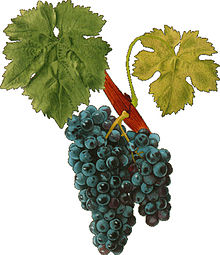
Back Каринян Bulgarian Carinyena Catalan Karinyeno CEB Кариньян CV Carignan noir German Cariñena (uva) Spanish Cariñena (mahatsa) Basque Carignan N French קריניאן HE Carignan Croatian
| Carignan | |
|---|---|
| Grape (Vitis) | |
 Carignan in Viala & Vermorel | |
| Color of berry skin | Noir |
| Also called | See list of synonyms |
| Origin | Cariñena, Aragon |
| Notable regions | Languedoc, Sardinia, Algeria and Catalonia |
| Notable wines | Historically Cariñena and Rioja but little used now |
| Hazards | Rot, powdery mildew, downy mildew and grape worms. Late budding and ripening |
| VIVC number | 2098 |
Carignan (also known as Mazuelo, Bovale Grande, Cariñena, Carinyena, Samsó, Carignane, and Carignano) is a red grape variety of Spanish origin that is more commonly found in French wine but is widely planted throughout the western Mediterranean and around the globe. Along with Aramon, it was considered one of the main grapes responsible for France's wine lake and was a substantial producer in jug wine production in California's Central Valley but in recent years, it has been reborn as a flagship wine for many cellars in the south of France as well as in Catalonia.[1][2]
Ampelographers believe that the grape likely originated in Cariñena, Aragon and was later transplanted to Sardinia, elsewhere in Italy, France, Algeria, and much of the New World. The variety was historically a component of Rioja's red wine blend. The grape's prominence in France hit a high point in 1988 when it accounted for 167,000 hectares (410,000 acres) and was France's most widely planted grape variety. That year, in a drive to increase the overall quality of European wine and to reduce the growing wine lake phenomenon, the European Union started an aggressive vine pull scheme where vineyard owners were offered cash subsidies in exchange for pulling up their vines. Out of all the French wine varieties, Carignan was the most widely affected dropping by 2000 to 95,700 ha (236,000 acres) and being surpassed by Merlot as the most widely planted grape.[3]
The popularity of Carignan was largely tied to its ability to produce very large yields in the range of 200 hl/ha (11 tons/acre). The vine does face significant viticultural hazards with significant sensitivity to several viticultural hazards including rot, powdery mildew, downy mildew, and grape worms. Carignan is a late budding and ripening grape which requires a warm climate in order to achieve full physiological ripeness.[2] The vine also develops very thick stalk around the grape clusters which makes mechanical harvesting difficult. It has an upright growth habit and can be grown without a trellis.[4]
A white grape mutation known as Carignan blanc and a pink-berried Carignan gris also exists in Roussillon in small plantings of around 411 hectares (1,020 acres) and 1 hectare (2.5 acres), respectively, reported in 2008.[4]
- ^ Cite error: The named reference
w6was invoked but never defined (see the help page). - ^ a b Oz Clarke Encyclopedia of Grapes pg 58 Harcourt Books 2001 ISBN 0-15-100714-4
- ^ J. Robinson (ed) The Oxford Companion to Wine Third Edition pg 139 Oxford University Press 2006 ISBN 0-19-860990-6
- ^ a b J. Robinson, J. Harding and J. Vouillamoz Wine Grapes - A complete guide to 1,368 vine varieties, including their origins and flavours pgs 616-619 Allen Lane 2012 ISBN 978-1-846-14446-2
© MMXXIII Rich X Search. We shall prevail. All rights reserved. Rich X Search